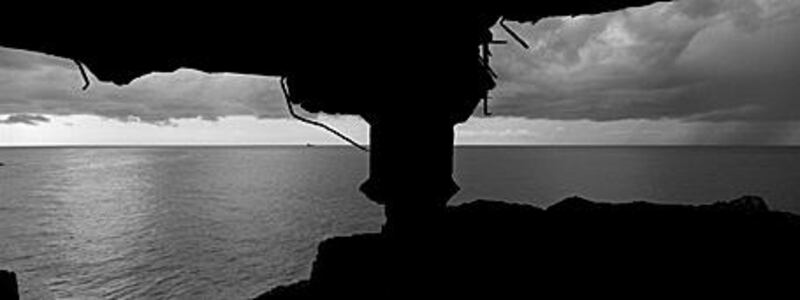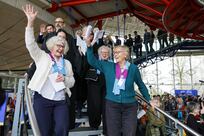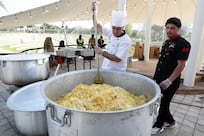SYDNEY // Second World War veterans and historians have urged authorities in Australia's remote Northern Territory to do more to preserve remnants and memories of the repeated bombing of Darwin by Japanese forces during the 1940s.
The tropical city was attacked 64 times from February 1942 until November 1943 in a series of air raids that fundamentally changed Australia's attitudes to its Asian neighbours as well as recasting its relationship with colonial Britain. "These events in Darwin simply showed that Australia was wide open and virtually defenceless against aggression and that the [British] imperial defence shield counted for nothing," said Peter Forrest, a historian and writer. "It really was a psychologically devastating event for Australia and a turning point for the way in which Australians saw their place in the world and how they might in the future look to America for protection rather than Britain. It was a moment when Australia grew up."
The bombardment of this northern outpost was the largest assault ever mounted by a foreign power against Australia and traces of those fear-filled days can be found in and around Darwin. Perched on the city's East Point peninsula is a small military museum, along with gun positions, bunkers and observation towers that gaze out over the Timor Sea, while beside the main motorway heading south are the remains of runways the Americans built for allied fighters. Hidden far from view in nearby bush land are decrepit machine gun nests fashioned from oil drums as well as forgotten ammunition dumps, which have withered under the corrosive onslaught of the monsoon.
Mr Forrest has called on the authorities to adopt a "systematic plan" to preserve these fading relics of a pivotal period in Australia's recent history amid concerns that many will be lost forever. The Northern Territory government is planning a museum dedicated to telling Darwin's wartime story and officials from the city council have affirmed their "strong commitment" to promoting events that commemorate the region's wartime heritage.
Each February a dwindling number of veterans attend ceremonies to mark the first wave of Japanese bombings on Darwin almost 70 years ago. For years Basil Stahl has made the long journey from his home on Queensland's Sunshine Coast to the capital of the Northern Territory to remember his colleagues but is worried that the brutal and sustained aerial assault has slipped from the nation's consciousness.
"School kids around Australia all know about Pearl Harbor but have never learnt anything about the bombing of Darwin. They wouldn't have a clue," said Mr Stahl, 87, who joined the army survey corps as a teenager. "When the [Japanese] bombed on just about 10 o'clock on the 19th [of February] we were a little bit prepared. We had trenches dug but not anything else. They hit us again at midday. A 500-pound bomb dropped in the grounds of Larrakia barracks. It was one of the first to be dropped, which was very close to us," he explained.
That day, about 250 enemy aircraft targeted Darwin harbour and other military installations. Strategic planners had been frantically bolstering protection against a naval attack but the city was left horribly exposed to air raids, which were considered unlikely given its remoteness. At the time, Mr Stahl and his unit were expecting the arrival of allied aircraft to boost Darwin's flimsy aerial defences.
"All of a sudden we looked up and there was a big silver group of aeroplanes but there was no indication they were [Japanese] or anything. They were so high up that we just thought they were the reinforcements coming. A few seconds later it was bang, bang, bang everywhere and that was it." It is estimated that 300 service personnel and civilians died in the 21-month Japanese operation, which stretched as far as Port Hedland in Western Australia and Townsville in Queensland on the eastern side of the continent.
According to Mr Forrest, the historian, Australia had feared an attack from Asia even before the Second World War and the raids on Darwin seemed to confirm suspicions about the threat of the "Yellow Peril" - otherwise known as Japan. But, said Mr Forrest: "We now know that Japan did not have any concrete plans to invade Australia and it simply didn't have the resources, but it didn't look that way in February 1942."
Eric Eustance, a tour guide at the giant oil storage tunnels constructed in secret in Darwin after May 1943, believes there should be a greater awareness of the area's rich military history. "I believe there are a quite a number of people in Darwin who live here that don't know where these tunnels are. I'm quite sure of that," Mr Eustance explained. "Ninety per cent of the tourists that turn up here at the tunnels know very little about the war. Most of them know Darwin was bombed but you tell them it was 64 times, they're aghast," he added.
pmercer@thenational.ae





